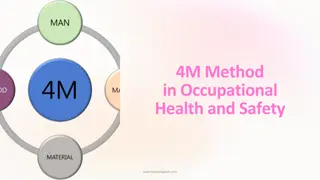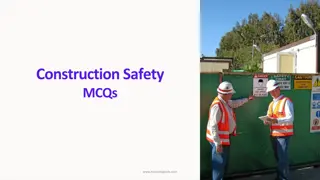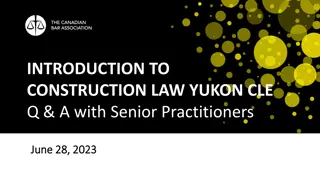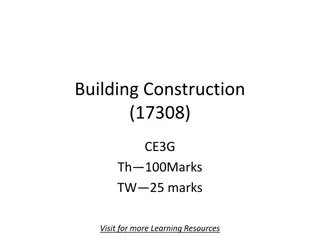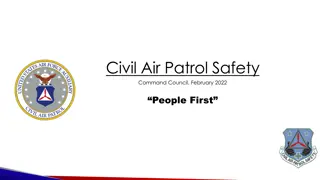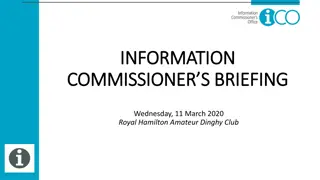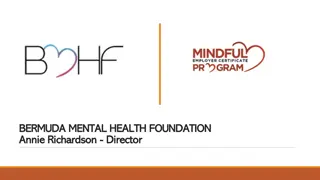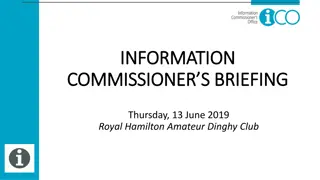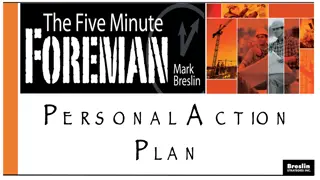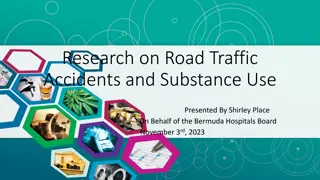Bermuda Construction Safety Council 2020 Overview
The Bermuda Construction Safety Council focuses on meeting workforce demands in education, work experience, and sporting activities. They provide essential safety services, regulate safety professionals, anticipate hazards, and promote growth training. The council encourages open communication with workers and aims to create a safe and healthy work environment in Bermuda.
Download Presentation

Please find below an Image/Link to download the presentation.
The content on the website is provided AS IS for your information and personal use only. It may not be sold, licensed, or shared on other websites without obtaining consent from the author.If you encounter any issues during the download, it is possible that the publisher has removed the file from their server.
You are allowed to download the files provided on this website for personal or commercial use, subject to the condition that they are used lawfully. All files are the property of their respective owners.
The content on the website is provided AS IS for your information and personal use only. It may not be sold, licensed, or shared on other websites without obtaining consent from the author.
E N D
Presentation Transcript
HOUSE KEEPING -2 Dr Versha Prasad
CLEANING IN HEALTHCARE ORGANISATION Good cleaning practices are essential for reducing the risk of transmitting infectious diseases. This will contribute to a culture of safety by providing an atmosphere of general cleanliness and good order. Cleaning best practices are designed to meet the following needs: The primary focus must remain the safety of the patient, staff and visitors. The practices must help reduce the spread of infections. The practices are easily understood and achievable. The practices incorporate workflow measurement to guide human resource issues. The practices must be reviewed as often as required to keep abreast of changes in the health care.
ENVIRONMENTAL CLEANING Sanitation staff must adhere to routine practices while cleaning. Routine cleaning practices are practices that are used wherever cleaning is being carried out. The principles of routine practices are based on the premise that all patients, their secretions, excretions and body fluids and their environment might potentially be contaminated with harmful microorganisms. By following simple preventive practices at all times regardless of whether or not an illness is known , staff will be protecting patients and themselves from an unknown, undiagnosed infectious risk. Routine Practices related to environmental cleaning include: Hand hygiene. Use of personal protective equipment (PPE) when indicated. Standardized cleaning protocols.
HAND HYGINE Hand hygiene is the most important and effective measure to prevent the spread of health care-associated infections. Therefore, hand hygiene must be practiced: Before initial patient/patient environment contact (e.g. before coming into the patient room or bed space). After potential body fluid exposure (e.g. after cleaning bathroom, handling soiled linen, equipment or waste etc.). After patient/patient environment contact (e.g., after cleaning patient room; after cleaning equipment such as stretchers; after changing mop heads etc.). Dedicated hand washing sinks are required for hand washing with soap and water, to avoid splash back of microorganisms onto clean hands during rinsing. Hand washing sinks must not be used for other purposes, such as disposal of fluids or cleaning of equipment.(
PERSONAL PROTECTIVE EQUIPMENT (PPE) Personal protective equipment (PPE) for health care providers and other staff refers to a variety of barriers used alone or in combination to protect mucous membranes, airways, skin and clothing from contact with infectious agents and from chemical agents. Cleaning staff should wear PPE: For protection from microorganisms. For protection from chemicals used in cleaning. To prevent transmission of microorganisms from one patient environment to another.
Hospital Administrators must ensure that PPE are available adequately and accessible to all sanitary /cleaning staff in their work area. Adequate induction and in-service training should be provided in infection control and use of PPE. PPE includes the following: Heavy duty gloves Impermeable plastic apron Gum boots Disposable mask and caps Eye protection wherever required
CLEANING FREQUENCY he frequency of cleaning and disinfecting individual items or surfaces in a particular area or department depends on: Whether surfaces are high-touch or low-touch. The type of activity taking place in the area and the risk of infection associated with it (e.g., critical care areas vs. meeting room) The vulnerability of patients in the area. The probability of contamination based on the amount of body fluid contamination surfaces in the area might have or be expected to have.
FREQUENCY OF CONTACT WITH SURFACES All surfaces in a health care organisation have the potential to harbour pathogenic microorganisms. The potential for exposure to pathogens is based on the frequency of contact with a contaminated surface and the type of activity involved. For example, a conference room table would have less potential for exposure to pathogens than the doorknob in a patient care area. High-touch surfaces will require more frequent cleaning regimen. Most, if not all, environmental surfaces will be adequately cleaned with soap and water or a detergent/disinfectant, depending on the nature of the surface and the type and degree of contamination.
HIGH-TOUCH SURFACES High-touch surfaces are those that have frequent contact with hands. Examples include doorknobs, elevator buttons, telephones, call bells, bedrails, light switches, computer keyboards, monitoring equipment, hemodialysis machines, wall areas around the toilet and edges of privacy curtains. High-touch surfaces in patient care areas require more frequent cleaning and disinfection than minimal contact surfaces. Cleaning and disinfection is usually done at least daily and more frequently if the risk of environmental contamination is higher (e.g., intensive care units).
LOW-TOUCH SURFACES Low-touch surfaces are those that have minimal contact with hands. Examples include walls, ceilings, mirrors and window sills. Low-touch surfaces require cleaning on a regular (but not necessarily daily) basis, when soiling or spills occur, and when a patient is discharged from the health care setting. Many low-touch surfaces may be cleaned on a periodic basis rather than a daily basis if they are also cleaned when visibly soiled.
VULNERABILITY OF THE PATIENT/RESIDENT POPULATION Different populations of patients have differing vulnerabilities based on their susceptibility to infection due to their medical condition or lack of immunity. In some populations, such as bone marrow transplant or burn patients, and those undergoing invasive or operative procedures, susceptibility to infection is very high and may be impacted by their environment. The frequency of cleaning may be higher in areas with vulnerable patients. For the purpose of risk stratification for cleaning, all other individuals are classified as less susceptible.
PROBABILITY OF CONTAMINATION OF ITEMS AND SURFACES The probability that a surface, piece of equipment or patient care area will be contaminated is based on the activity in the area, the type of pathogens involved and the microbial load. Areas that are heavily soiled with blood or other body fluids will require more frequent cleaning and disinfection than areas that are minimally soiled or not soiled Heavy Contamination An area is considered to be heavily contaminated if surfaces are exposed to copious amounts of blood or other body fluids (e.g., birthing suite, autopsy suite, cardiac catheterization laboratory, burn unit, haemodialysis unit, Emergency Department, bathroom if the patient has diarrhea or is incontinent).
PROBABILITY OF CONTAMINATION OF ITEMS AND SURFACES Moderate Contamination An area is considered to be moderately contaminated if surfaces are contaminated with blood or other body fluids as part of routine activity (e.g., patient/resident room, bathroom if patient is continent) and the contaminated substances are contained or removed. All patients bed space/rooms and bathrooms should be considered to be, as a minimum, moderately contaminated. Light Contamination An area is considered to be lightly contaminated or not contaminated if surfaces are not exposed to blood, other body fluids.
CLEANING PRACTICES Each health care setting must have policies and procedures to ensure that: Cleaning is a continuous event in the health care organization. Cleaning procedures incorporate the principles of infection prevention and control. Cleaning standards, frequency and accountability for cleaning are clearly defined (i.e., who cleans, what and how do they clean and when do they clean it). Cleaning schedules ensure that no area is missed from routine cleaning. Statutory requirements are met in relation to: Biomedical waste management Environment Protection Act Food hygiene standards Pest control



